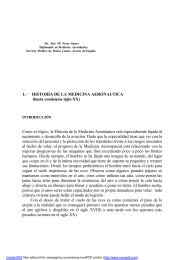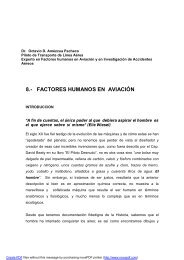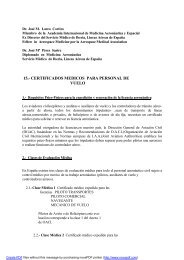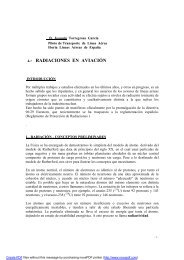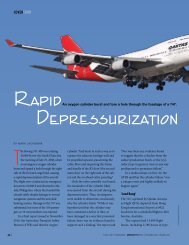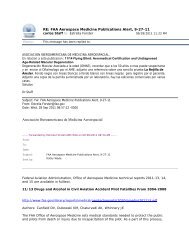AIMA Boletin Vol11 No2 (Diciembre/2010) - SEMA
AIMA Boletin Vol11 No2 (Diciembre/2010) - SEMA
AIMA Boletin Vol11 No2 (Diciembre/2010) - SEMA
Create successful ePaper yourself
Turn your PDF publications into a flip-book with our unique Google optimized e-Paper software.
TThhee MMiisshhaapp tthhaatt WWiillll KKiillll YYoouu<br />
by Capt. Shawnee Williams and Mr. Brian Johnson<br />
“What if I told you I knew, almost without a doubt, what flight parameters will set up a pilot for a fatal mishap? You would<br />
probably think I am either misinformed or over confident. After analyzing 11 years worth of Air Force Safety Center<br />
(AFSC) data, we have identified what kills pilots more than anything else. So, what is the major cause of Class A mishaps<br />
over the last decade? Spatial Disorientation (SD) was responsible for 11% of all aviation Class A mishaps over the last 11<br />
fiscal years (see figure 1); however, of the fatal mishaps, 42% were attributed to SD. Even more striking is the fact that<br />
65% of the fatal SD mishaps occurred in fighter aircraft (see figure 3). Spatial Disorientation is an incorrect perception of<br />
one’s linear and angular position and motion relative to the plane of the earth’s surface. Specifically, in the flight<br />
environment, SD is an erroneous perception of any of the parameters displayed by aircraft control and performance flight<br />
instruments (AFMAN 11‐217 Vol 1, Ch. 17). The erroneous perception is due to a mismatch between the visual and<br />
vestibular systems. The visual system is dominated by conscious thought while the vestibular system is controlled<br />
subconsciously. Pilots become disoriented when their vestibular system becomes the dominant means for orientation.<br />
When your attention is focused on something other than maintaining attitude and altitude or channelized on a specific<br />
task, this is the time when the vestibular system takes over, often giving unreliable and incorrect inputs, putting aviators<br />
at risk for unrecognized Spatial Disorientation or Type I SD. So which flying communities does this apply to and what<br />
portions of the mission leaves a pilot more susceptible to SD? It is important to note that pilots of multi‐place aircraft and<br />
helicopter pilots can and will experience spatial disorientation, but pilots of high performance, single seat fighters have a<br />
higher propensity for SD. More specifically, it is aviators with an average of 2500 flying hours in the F‐16, F‐15 and A‐10<br />
communities. 34% of the SD mishaps occurred in the F‐16C/J communities with the F‐15E/A‐10A airframes comprising<br />
another 17% (see Figure 2). Now that you know the physiological parameters for SD and in which airframes it most<br />
commonly occurs, lets address flight parameters.<br />
Figure 1 (left): Class A Aviation SD Mishaps over the Last 11 Years (Oct 1999 to Sept 2009)<br />
Figure 2 (right): SD Class A Mishaps by Airframe (Oct 1999 to Sept 2009)<br />
Most aviators assume that the setup for Type I SD is in the weather (i.e. the leans). However, recent AFSC analysis shows<br />
exactly the opposite. While experiencing Type I SD, in the weather, is dangerous it will most likely not lead to a fatal<br />
mishap. Rather, task intensive parts of the mission at night, low altitude, low to moderate Gs, slight bank and tactical<br />
employment are what will put you at the highest risk for Type I unrecognized SD, which is the most dangerous type of SD.<br />
The question at hand is does your “Mother Hood” brief state “Caution: if you experience SD, recover on the round dials<br />
and declare a knock it off”? Does it also include the threats of weather and SD? As stated before, if you believe weather<br />
is your greatest hazard to SD you are not capturing the real threat.<br />
The human factor threat arises when aviators lose track of the fundamentals. Pilots must be informed of the<br />
compounding effects during their entire sortie. The combination of flying at night, under moderate Gs while performing<br />
maneuvers such as Tactical Intercept (TI), surface attack tactics (SAT) or strafe creates the perfect environment for Type I<br />
SD. This information must be applied throughout the entirety of your brief. For example: capture the times during<br />
tactical employment that your 2/4 ship is at risk for Type I SD and how to mitigate.<br />
3





